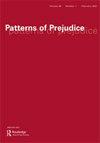Bringing the enemy closer to home: ‘conspiracy talk’ and the Norwegian far right
IF 0.8
2区 社会学
Q4 ETHNIC STUDIES
引用次数: 1
Abstract
ABSTRACT What is the appeal of joining online communities obsessed with images of enemies and filled with threatening narratives? Døving and Emberland’s article introduces the term ‘conspiracy talk’ as a useful analytical concept for answering this question. The activities of radical and populist right-wing groups in Europe have increased in recent years; in particular, they use the Internet to propagate, discuss and enhance their ideological message. On Facebook and in comments on ‘alternative’ news sites, individuals share narratives about how an invasion of Muslims will lead to the imminent downfall of European civilization unless it is not rescued by the introduction of authoritarian, ethnic nationalism. The ideology of the far right is a growing field for research but there are few studies on how the ideology is spread and rendered meaningful via discussions and comments among Internet-based communities. This article, based on analyses of the content of various websites and Facebook pages that are part of the far-right landscape of Norway, seeks to explore the role conspiracy claims play in conversations taking place within these virtual communities. It attempts to identify patterns of communication and ways of talking that make conspiratorial notions seem reasonable. Døving and Emberland argue that radical-right and right-wing populist ideas are made relevant and gain a sense of immediacy through conspiracy talk. Conspiracy talk renders conspiracy narratives meaningful by linking them to the local contexts of the participants.让敌人离我们更近:“阴谋论”和挪威极右翼
摘要加入痴迷于敌人形象、充满威胁叙事的网络社区有什么吸引力?Døving和Emberland的文章介绍了“阴谋论”一词,作为回答这个问题的一个有用的分析概念。近年来,欧洲激进和民粹主义右翼团体的活动有所增加;特别是,他们利用互联网来传播、讨论和增强他们的意识形态信息。在脸书上和“另类”新闻网站上的评论中,个人分享了对穆斯林的入侵将如何导致欧洲文明即将崩溃的故事,除非引入威权主义和种族民族主义来拯救欧洲文明。极右翼的意识形态是一个不断增长的研究领域,但很少有研究表明这种意识形态是如何在互联网社区中通过讨论和评论传播和变得有意义的。这篇文章基于对挪威极右翼网站和脸书页面内容的分析,试图探讨阴谋论在这些虚拟社区中的对话中所起的作用。它试图找出使阴谋论看起来合理的沟通模式和谈话方式。Døving和Emberland认为,激进的右翼民粹主义思想具有相关性,并通过阴谋论获得即时感。阴谋论通过将阴谋论与参与者的当地背景联系起来,使其具有意义。
本文章由计算机程序翻译,如有差异,请以英文原文为准。
求助全文
约1分钟内获得全文
求助全文
来源期刊

Patterns of Prejudice
Multiple-
CiteScore
2.50
自引率
0.00%
发文量
11
期刊介绍:
Patterns of Prejudice provides a forum for exploring the historical roots and contemporary varieties of social exclusion and the demonization or stigmatisation of the Other. It probes the language and construction of "race", nation, colour, and ethnicity, as well as the linkages between these categories. It encourages discussion of issues at the top of the public policy agenda, such as asylum, immigration, hate crimes and citizenship. As none of these issues are confined to any one region, Patterns of Prejudice maintains a global optic, at the same time as scrutinizing intensely the history and development of intolerance and chauvinism in the United States and Europe, both East and West.
 求助内容:
求助内容: 应助结果提醒方式:
应助结果提醒方式:


